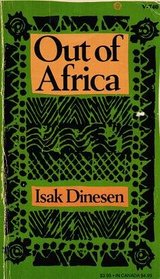Helpful Score: 1
Haunting and unforgettable. A "keeper," so far as I'm concerned!
Helpful Score: 1
an all-time favorite, i've read and re-read this many times
This is a great autobiography
From 500 Great Books by Women; review by Lynne Auld
From 1914 to 1931, Danish aristocrat Baroness Karen Blixen owned and operated a coffee plantation in Kenya. After the plantation failed, she returned to Europe and began to write under the pen name Isak Dinesen. Out of Africa reads like a collection of stories in which she adheres to no strict chronology, gives no explanation of the facts of her life, and apologizes for nothing. First published in 1937, Out of Africa is not free of the colonial or racist attitudes of its time; yet, within that context, Isak Dinesen is an enlightened observer and participant as she describes the experience of British East Africa before World War II. She portrays in rich detail the vast land around her, alive with strange and wonderful human populations; the thrilling terror of a nocturnal lion hunt; a shooting accident among the Africans on her farm and its repercussions; raising and freeing an orphaned antelope fawn; getting to know the Africans and the colonial adventurers who found their way into her life. "If I know a song of Africa," she writes, "of the Giraffe, and the African new moon lying on her back, of the ploughs in the fields, and the sweaty faces of the coffee-pickers, does Africa know a song of me?" Out of Africa is that song.
From 500 Great Books by Women; review by Lynne Auld
From 1914 to 1931, Danish aristocrat Baroness Karen Blixen owned and operated a coffee plantation in Kenya. After the plantation failed, she returned to Europe and began to write under the pen name Isak Dinesen. Out of Africa reads like a collection of stories in which she adheres to no strict chronology, gives no explanation of the facts of her life, and apologizes for nothing. First published in 1937, Out of Africa is not free of the colonial or racist attitudes of its time; yet, within that context, Isak Dinesen is an enlightened observer and participant as she describes the experience of British East Africa before World War II. She portrays in rich detail the vast land around her, alive with strange and wonderful human populations; the thrilling terror of a nocturnal lion hunt; a shooting accident among the Africans on her farm and its repercussions; raising and freeing an orphaned antelope fawn; getting to know the Africans and the colonial adventurers who found their way into her life. "If I know a song of Africa," she writes, "of the Giraffe, and the African new moon lying on her back, of the ploughs in the fields, and the sweaty faces of the coffee-pickers, does Africa know a song of me?" Out of Africa is that song.
Wonderful!
Living in Africa and managing a coffee farm, the author describes her experiences raising coffee and her interaction with the natives who work at the farm and serve as servants. Kamante, a strange native whose values are different from most natives, becomes her chef. For examples, he relates well to animals and cares for them as the author might. When a young bushbuck named Lulu becomes part of her life, Kamante takes charge of her care and feeding thus bonding with her. The book is filled with tale after tale about her African experiences. This is a read to peruse with care as tale after tale stands alone. Others, however, link to give a more complete view of how her life unfolded.
For examples, a shooting accident on the farm is the result of children playing with a gun. One boy is killed and another badly injured. The boy who did the shooting disappears and his father must make amends to the dead boy's family. The old men determine the number of animals the family receives. Tribal beliefs and tradition are important in such cases. The situation is examined from many angles it takes a long time. Much later in the book, the boy reappears, grown up and accepted as a valued member of native society and works on the farm.
On the other hand, the friendship with Denys is treasured and related with a clearness that portrays the depth the author felt for this charismatic individual. When he dies in a crash of his plane, the burial scene is related with the same depth emphasizing again the depth of the friendship. This is one I could read again and again.
For examples, a shooting accident on the farm is the result of children playing with a gun. One boy is killed and another badly injured. The boy who did the shooting disappears and his father must make amends to the dead boy's family. The old men determine the number of animals the family receives. Tribal beliefs and tradition are important in such cases. The situation is examined from many angles it takes a long time. Much later in the book, the boy reappears, grown up and accepted as a valued member of native society and works on the farm.
On the other hand, the friendship with Denys is treasured and related with a clearness that portrays the depth the author felt for this charismatic individual. When he dies in a crash of his plane, the burial scene is related with the same depth emphasizing again the depth of the friendship. This is one I could read again and again.




